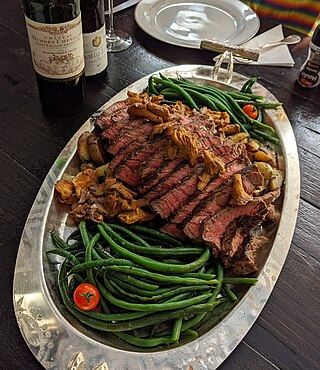
A beefsteak, often called just steak, is a flat cut of beef with parallel faces, usually cut perpendicular to the muscle fibers. In common restaurant service a single serving has a raw mass ranging from 120 to 600 grams. Beef steaks are usually grilled, pan-fried, or broiled. The more tender cuts from the loin and rib are cooked quickly, using dry heat, and served whole. Less tender cuts from the chuck or round are cooked with moist heat or are mechanically tenderized.

Offal, also called variety meats, pluck or organ meats, is the internal organs of a butchered animal. The word does not refer to a particular list of edible organs, and these lists of organs vary with culture and region, but usually exclude skeletal muscle. Offal may also refer to the by-products of milled grains, such as corn or wheat.
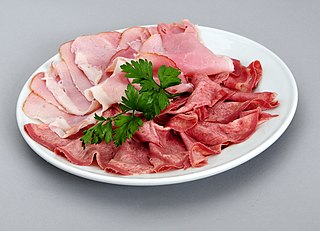
Lunch meats—also known as cold cuts, luncheon meats, cooked meats, sliced meats, cold meats, sandwich meats, delicatessens, and deli meats—are precooked or cured meats that are sliced and served cold or hot. They are typically served in sandwiches or on a tray. They can be purchased pre-sliced, usually in vacuum packs, or they can be sliced to order.

Asado is the technique and the social event of having or attending a barbecue in various South American countries: especially Argentina, Brazil, Chile, Paraguay, Peru, and Uruguay where it is also a traditional event. An asado usually consists of beef, pork, chicken, chorizo, and morcilla; all of which are cooked using an open fire or a grill, called a parrilla. Usually, red wine and side dishes such as salads accompany the main meats, which are prepared by a designated cook called the asador or parrillero.

Butterflying is a way of preparing meat, fish, or poultry for cooking by cutting it almost in two, but leaving the two parts connected; it is then often boned and flattened. Spatchcocking is a specific method for butterflying poultry that involves removing the backbone, and spatchcock as a noun may refer to a bird prepared in that way.
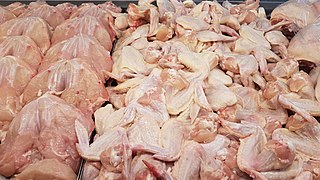
In culinary terms, white meat is meat which is pale in color before and after cooking. In traditional gastronomy, white meat also includes rabbit, the flesh of milk-fed young mammals, and sometimes pork. In ecotrophology and nutritional studies, white meat includes poultry and fish, but excludes all mammal flesh, which is considered red meat.

Pork ribs are a cut of pork popular in Western and Asian cuisines. The ribcage of a domestic pig, meat and bones together, is cut into usable pieces, prepared by smoking, grilling, or baking – usually with a sauce, often barbecue – and then served.
Cutlet refers to:
- a thin slice of meat from the leg or ribs of mutton, veal, pork, or chicken
- a dish made of such slice, often breaded
- a croquette or cutlet-shaped patty made of ground meat
- a kind of fish cut where the fish is sliced perpendicular to the spine, rather than parallel ; often synonymous with steak
- a prawn or shrimp with its head and outer shell removed, leaving only the flesh and tail
- a mash of vegetables fried with bread
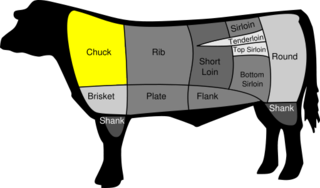
Chuck steak is a cut of beef and is part of the sub-prime cut known as the chuck.
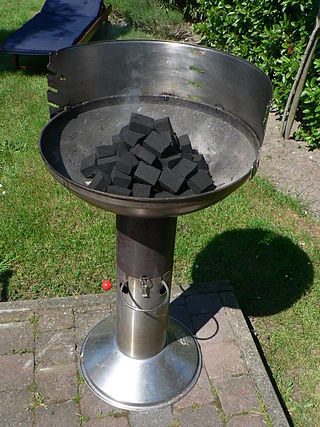
Barbecue varies by the type of meat, sauce, rub, or other flavorings used, the point in barbecuing at which they are added, the role smoke plays, the equipment and fuel used, cooking temperature, and cooking time.

A fillet or filet is a boneless cut or slice of meat or fish. The fillet is often a prime ingredient in many cuisines, and many dishes call for a specific type of fillet as one of the ingredients.
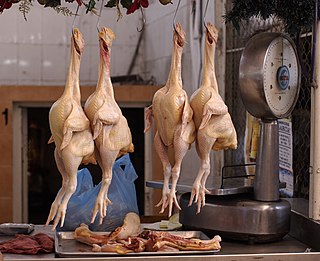
Chicken is the most common type of poultry in the world. Owing to the relative ease and low cost of raising chickens—in comparison to mammals such as cattle or hogs—chicken meat and chicken eggs have become prevalent in numerous cuisines.

A meat chop is a cut of meat cut perpendicular to the spine, and usually containing a rib or riblet part of a vertebra and served as an individual portion. The most common kinds of meat chops are pork and lamb. A thin boneless chop, or one with only the rib bone, may be called a cutlet, though the difference is not always clear. The term "chop" is not usually used for beef, but a T-bone steak is essentially a loin chop, a rib steak and a rib cutlet.

A steak is a thick cut of meat generally sliced across the muscle fibers, sometimes including a bone. It is normally grilled or fried. Steak can be diced, cooked in sauce, such as in steak and kidney pie, or minced and formed into patties, such as hamburgers.

A fish steak, alternatively known as a fish cutlet, is a cut of food fish which is perpendicular to the spine and can either include the bones or as boneless meat. Fish steaks can be contrasted with fish fillets, which are cut parallel to either side of the spine and do not include any large bones. Fish steaks can be made with the skin on or without, and are generally made from fish larger than 4.5 kilograms (10 lb). Fish steaks from particularly large fish can be sectioned so they are boneless.

Breaded cutlet or braised cutlet is a dish made from coating a cutlet of meat with breading or batter and either frying or baking it.
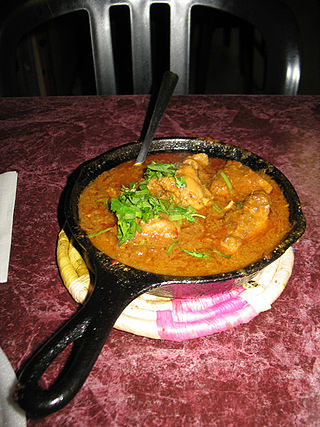
Meat plays a much more dominant role in Pakistani cuisine, compared to other South Asian cuisines. Of all the meats, the most popular are chicken, lamb, beef, goat, and fish.Beef is particularly sought after as the meat of choice for kebab dishes or the classic beef shank dish nihari. Seafood is generally not consumed in large amounts, though it is very popular in the coastal areas of Sindh and the Makran coast of Balochistan.

A stew is a combination of solid food ingredients that have been cooked in liquid and served in the resultant gravy. Ingredients can include any combination of vegetables and may include meat, especially tougher meats suitable for slow-cooking, such as beef, pork, venison, rabbit, lamb, poultry, sausages, and seafood. While water can be used as the stew-cooking liquid, stock is also common. A small amount of red wine or other alcohol is sometimes added for flavour. Seasonings and flavourings may also be added. Stews are typically cooked at a relatively low temperature, allowing flavours to mingle.


















